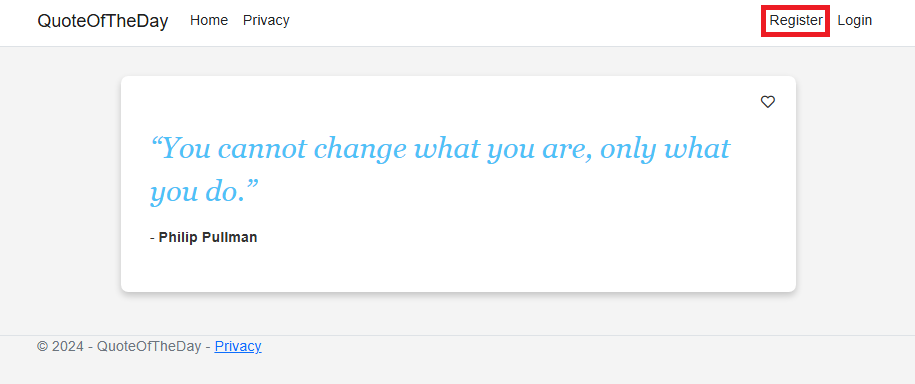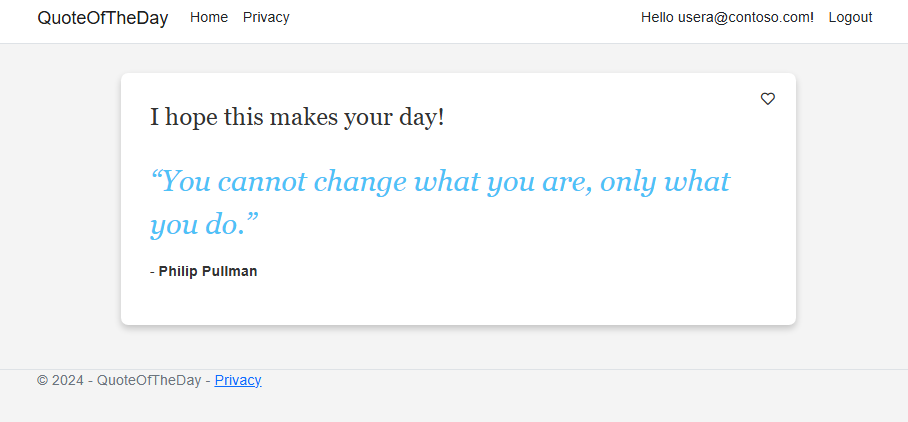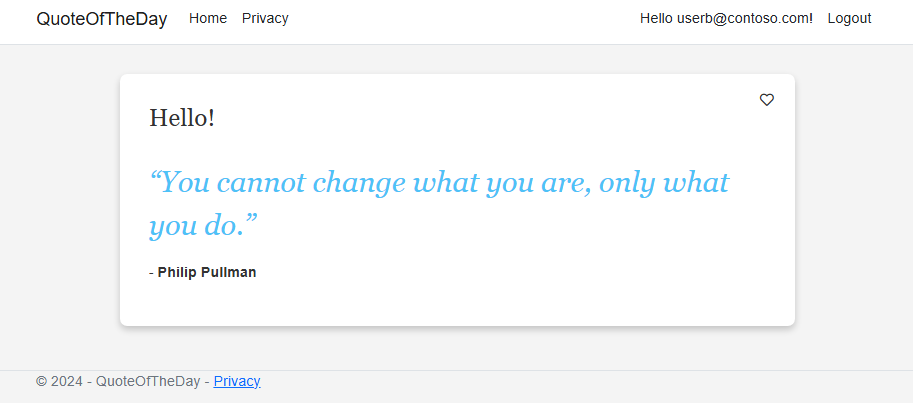Use variant feature flags in a Python application
In this tutorial, you use a variant feature flag to manage experiences for different user segments in an example application, Quote of the Day. You utilize the variant feature flag created in How to variant feature flags. Before proceeding, ensure you create the variant feature flag named Greeting in your App Configuration store.
Prerequisites
- Python 3.8 or later - for information on setting up Python on Windows, see the Python on Windows documentation
- Follow the How to variant feature flags tutorial and create the variant feature flag named Greeting.
Set up a Python Flask web app
If you already have a Python Flask web app, you can skip to the Use the variant feature flag section.
Create a new project folder named QuoteOfTheDay.
Create a virtual environment in the QuoteOfTheDay folder.
python -m venv venvActivate the virtual environment.
.\venv\Scripts\ActivateInstall the latest versions of the following packages.
pip install flask pip install flask-login pip install flask_sqlalchemy pip install flask_bcrypt
Create the Quote of the Day app
Create a new file named
app.pyin theQuoteOfTheDayfolder with the following content. It sets up a basic Flask web application with user authentication.from flask_bcrypt import Bcrypt from flask_sqlalchemy import SQLAlchemy from flask_login import LoginManager from flask import Flask app = Flask(__name__, template_folder="../templates", static_folder="../static") bcrypt = Bcrypt(app) db = SQLAlchemy() db.init_app(app) login_manager = LoginManager() login_manager.init_app(app) from .model import Users @login_manager.user_loader def loader_user(user_id): return Users.query.get(user_id) with app.app_context(): db.create_all() if __name__ == "__main__": app.run(debug=True) from . import routes app.register_blueprint(routes.bp)Create a new file named model.py in the QuoteOfTheDay folder with the following content. It defines a
Quotedata class and a user model for the Flask web application.from dataclasses import dataclass from flask_login import UserMixin from . import db @dataclass class Quote: message: str author: str # Create user model class Users(UserMixin, db.Model): id = db.Column(db.Integer, primary_key=True) username = db.Column(db.String(250), unique=True, nullable=False) password_hash = db.Column(db.String(250), nullable=False) def __init__(self, username, password): self.username = username self.password_hash = passwordCreate a new file named routes.py in the QuoteOfTheDay folder with the following content. It defines routes for the Flask web application, handling user authentication and displaying a homepage with a random quote.
import random from flask import Blueprint, render_template, request, flash, redirect, url_for from flask_login import current_user, login_user, logout_user from . import db, bcrypt from .model import Quote, Users bp = Blueprint("pages", __name__) @bp.route("/", methods=["GET", "POST"]) def index(): context = {} user = "" if current_user.is_authenticated: user = current_user.username context["user"] = user else: context["user"] = "Guest" if request.method == "POST": return redirect(url_for("pages.index")) quotes = [ Quote("You cannot change what you are, only what you do.", "Philip Pullman"), ] greeting_message = "Hi" context["model"] = {} context["model"]["greeting_message"] = greeting_message context["model"]["quote"] = {} context["model"]["quote"] = random.choice(quotes) context["isAuthenticated"] = current_user.is_authenticated return render_template("index.html", **context) @bp.route("/register", methods=["GET", "POST"]) def register(): if request.method == "POST": password = request.form.get("password") hashed_password = bcrypt.generate_password_hash(password).decode('utf-8') user = Users(request.form.get("username"), hashed_password) try: db.session.add(user) db.session.commit() except Exception as e: flash("Username already exists") return redirect(url_for("pages.register")) login_user(user) return redirect(url_for("pages.index")) return render_template("sign_up.html") @bp.route("/login", methods=["GET", "POST"]) def login(): if request.method == "POST": user = Users.query.filter_by(username=request.form.get("username")).first() password = request.form.get("password") if user and bcrypt.check_password_hash(user.password_hash, password): login_user(user) return redirect(url_for("pages.index")) return render_template("login.html") @bp.route("/logout") def logout(): logout_user() return redirect(url_for("pages.index"))Create a new folder named templates in the QuoteOfTheDay folder and add a new file named base.html in it with the following content. It defines the layout page for the web application.
<!DOCTYPE html> <html lang="en"> <head> <meta charset="utf-8" /> <meta name="viewport" content="width=device-width, initial-scale=1.0" /> <title>QuoteOfTheDay</title> <link href="https://cdn.jsdelivr.net/npm/bootstrap@5.3.3/dist/css/bootstrap.min.css" rel="stylesheet" integrity="sha384-QWTKZyjpPEjISv5WaRU9OFeRpok6YctnYmDr5pNlyT2bRjXh0JMhjY6hW+ALEwIH" crossorigin="anonymous"> <link rel="stylesheet" href="{{ url_for('static', filename='site.css') }}"> <link rel="stylesheet" href="https://cdnjs.cloudflare.com/ajax/libs/font-awesome/5.15.3/css/all.min.css"> </head> <body> <header> <nav class="navbar navbar-expand-sm navbar-toggleable-sm navbar-light bg-white border-bottom box-shadow mb-3"> <div class="container"> <a class="navbar-brand" href="/">QuoteOfTheDay</a> <button class="navbar-toggler" type="button" data-bs-toggle="collapse" data-bs-target=".navbar-collapse" aria-controls="navbarSupportedContent" aria-expanded="false" aria-label="Toggle navigation"> <span class="navbar-toggler-icon"></span> </button> <div class="navbar-collapse collapse d-sm-inline-flex justify-content-between"> <ul class="navbar-nav flex-grow-1"> <li class="nav-item"> <a class="nav-link text-dark" href="/">Home</a> </li> </ul> {% block login_partial %} <ul class="navbar-nav"> {% if isAuthenticated %} <li class="nav-item"> <a class="nav-link text-dark">Hello {{user}}!</a> </li> <li class="nav-item"> <a class="nav-link text-dark" href="/logout">Logout</a> </li> {% else %} <li class="nav-item"> <a class="nav-link text-dark" href="/register">Register</a> </li> <li class="nav-item"> <a class="nav-link text-dark" href="/login">Login</a> </li> {% endif %} </ul> {% endblock %} </div> </div> </nav> </header> <div class="container"> <main role="main" class="pb-3"> {% block content %} {% endblock %} </main> </div> </body> <footer class="border-top footer text-muted"> <div class="container"> © 2024 - QuoteOfTheDay </div> </footer> <script src="https://code.jquery.com/jquery-3.7.1.min.js" integrity="sha256-/JqT3SQfawRcv/BIHPThkBvs0OEvtFFmqPF/lYI/Cxo=" crossorigin="anonymous"></script> <script src="https://cdn.jsdelivr.net/npm/bootstrap@5.3.3/dist/js/bootstrap.bundle.min.js" integrity="sha384-YvpcrYf0tY3lHB60NNkmXc5s9fDVZLESaAA55NDzOxhy9GkcIdslK1eN7N6jIeHz" crossorigin="anonymous"></script> </body> </html>Create a new file named index.html in the templates folder with the following content. It extends the base template and adds the content block.
{% extends 'base.html' %} {% block content %} <div class="quote-container"> <div class="quote-content"> {% if model.greeting_message %} <h3 class="greeting-content">{{model.greeting_message}}</h3> {% endif %} <br /> <p class="quote">“{{model.quote.message}}”</p> <p>- <b>{{model.quote.author}}</b></p> </div> <div class="vote-container"> <button class="btn btn-primary" onclick="heartClicked(this)"> <i class="far fa-heart"></i> <!-- Heart icon --> </button> </div> <form action="/" method="post"> </form> </div> <script> function heartClicked(button) { var icon = button.querySelector('i'); icon.classList.toggle('far'); icon.classList.toggle('fas'); } </script> {% endblock %}Create a new file named sign_up.html in the templates folder with the following content. It defines the template for the user registration page.
{% extends 'base.html' %} {% block content %} <div class="login-container"> <h1>Create an account</h1> <form action="#" method="post"> <label for="username">Username:</label> <input type="text" name="username" /> <label for="password">Password:</label> <input type="password" name="password" /> <button type="submit">Submit</button> </form> </div> {% endblock %}Create a new file named login.html in the templates folder with the following content. It defines the template for the user login page.
{% extends 'base.html' %} {% block content %} <div class="login-container"> <h1>Login to your account</h1> <form action="#" method="post"> <label for="username">Username:</label> <input type="text" name="username" /> <label for="password">Password:</label> <input type="password" name="password" /> <button type="submit">Submit</button> </form> </div> {% endblock %}Create a new folder named static in the QuoteOfTheDay folder and add a new file named site.css in it with the following content. It adds CSS styles for the web application.
html { font-size: 14px; } @media (min-width: 768px) { html { font-size: 16px; } } .btn:focus, .btn:active:focus, .btn-link.nav-link:focus, .form-control:focus, .form-check-input:focus { box-shadow: 0 0 0 0.1rem white, 0 0 0 0.25rem #258cfb; } html { position: relative; min-height: 100%; } body { margin-bottom: 60px; } body { font-family: Arial, sans-serif; background-color: #f4f4f4; color: #333; } .quote-container { background-color: #fff; margin: 2em auto; padding: 2em; border-radius: 8px; max-width: 750px; box-shadow: 0px 4px 8px rgba(0, 0, 0, 0.2); display: flex; justify-content: space-between; align-items: start; position: relative; } .login-container { background-color: #fff; margin: 2em auto; padding: 2em; border-radius: 8px; max-width: 750px; box-shadow: 0px 4px 8px rgba(0, 0, 0, 0.2); justify-content: space-between; align-items: start; position: relative; } .vote-container { position: absolute; top: 10px; right: 10px; display: flex; gap: 0em; } .vote-container .btn { background-color: #ffffff; /* White background */ border-color: #ffffff; /* Light blue border */ color: #333 } .vote-container .btn:focus { outline: none; box-shadow: none; } .vote-container .btn:hover { background-color: #F0F0F0; /* Light gray background */ } .greeting-content { font-family: 'Georgia', serif; /* More artistic font */ } .quote-content p.quote { font-size: 2em; /* Bigger font size */ font-family: 'Georgia', serif; /* More artistic font */ font-style: italic; /* Italic font */ color: #4EC2F7; /* Medium-light blue color */ }
Use the variant feature flag
Install the latest versions of the following packages.
pip install azure-identity pip install azure-appconfiguration-provider pip install featuremanagement[AzureMonitor]Open the
app.pyfile and add the following code to the end of the file. It connects to App Configuration and sets up feature management.You use the
DefaultAzureCredentialto authenticate to your App Configuration store. Follow the instructions to assign your credential the App Configuration Data Reader role. Be sure to allow sufficient time for the permission to propagate before running your application.import os from azure.appconfiguration.provider import load from featuremanagement import FeatureManager from azure.identity import DefaultAzureCredential ENDPOINT = os.getenv("AzureAppConfigurationEndpoint") # Updates the flask app configuration with the Azure App Configuration settings whenever a refresh happens def callback(): app.config.update(azure_app_config) # Connect to App Configuration global azure_app_config azure_app_config = load( endpoint=ENDPOINT, credential=DefaultAzureCredential(), on_refresh_success=callback, feature_flag_enabled=True, feature_flag_refresh_enabled=True, ) app.config.update(azure_app_config) # Create a FeatureManager feature_manager = FeatureManager(azure_app_config)Open
routes.pyand add the following code to the end of it to refresh configuration and get the feature variant.from featuremanagement.azuremonitor import track_event from . import azure_app_config, feature_manager ... # Update the post request to track liked events if request.method == "POST": track_event("Liked", user) return redirect(url_for("pages.index")) ... # Update greeting_message to variant greeting = feature_manager.get_variant("Greeting", user) greeting_message = "" if greeting: greeting_message = greeting.configuration
Build and run the app
Set an environment variable named AzureAppConfigurationEndpoint to the endpoint of your App Configuration store found under the Overview of your store in the Azure portal.
If you use the Windows command prompt, run the following command and restart the command prompt to allow the change to take effect:
setx AzureAppConfigurationEndpoint "<endpoint-of-your-app-configuration-store>"If you use PowerShell, run the following command:
$Env:AzureAppConfigurationEndpoint = "<endpoint-of-your-app-configuration-store>"If you use macOS or Linux, run the following command:
export AzureAppConfigurationEndpoint='<endpoint-of-your-app-configuration-store'In the command prompt, in the QuoteOfTheDay folder, run:
flask run.Wait for the app to start, and then open a browser and navigate to
http://localhost:5000/.Once viewing the running application, select Register at the top right to register a new user.

Register a new user named usera@contoso.com.
Note
It's important for the purpose of this tutorial to use these names exactly. As long as the feature has been configured as expected, the two users should see different variants.
Select the Submit button after entering user information.
You're automatically logged in. You should see that usera@contoso.com sees the long message when viewing the app.

Logout with using the Logout button in the top right.
Register a second user named userb@contoso.com.
You're automatically logged in. You should see that userb@contoso.com sees the short message when viewing the app.

Next steps
For the full feature rundown of the Python feature management library, refer to the following document.